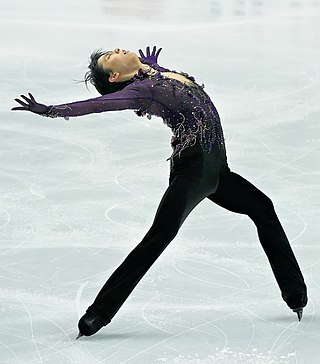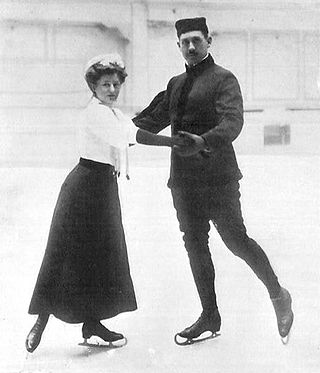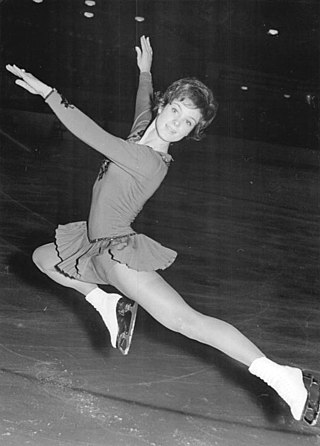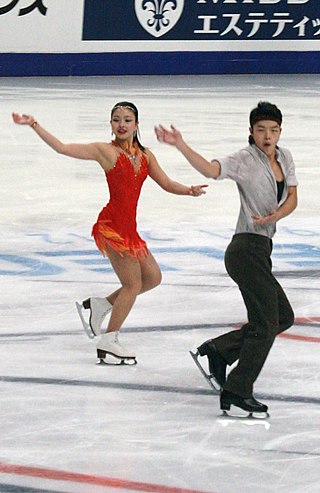
Figure skating is a sport in which individuals, pairs, or groups perform on figure skates on ice. It was the first winter sport to be included in the Olympic Games, with its introduction occurring at the 1908 Olympics in London. The Olympic disciplines are men's singles, women's singles, pair skating, and ice dance; the four individual disciplines are also combined into a team event, which was first included in the Winter Olympics in 2014. The non-Olympic disciplines include synchronized skating, Theater on Ice, and four skating. From intermediate through senior-level competition, skaters generally perform two programs, which, depending on the discipline, may include spins, jumps, moves in the field, lifts, throw jumps, death spirals, and other elements or moves.

Spins are an element in figure skating in which the skater rotates, centered on a single point on the ice, while holding one or more body positions. They are performed by all disciplines of the sport, single skating, pair skating, and ice dance, and are a required element in most figure skating competitions. As The New York Times says, "While jumps look like sport, spins look more like art. While jumps provide the suspense, spins provide the scenery, but there is so much more to the scenery than most viewers have time or means to grasp". According to world champion and figure skating commentator Scott Hamilton, spins are often used "as breathing points or transitions to bigger things".
The toe loop jump is the simplest jump in the sport of figure skating. It was invented in the 1920s by American professional figure skater Bruce Mapes. The toe loop is accomplished with a forward approach on the inside edge of the blade; the skater then switches to a backward-facing position before their takeoff, which is accomplished from the skater's right back outside edge and left toepick. The jump is exited from the back outside edge of the same foot. It is often added to more difficult jumps during combinations and is the most common second jump performed in combinations. It is also the most commonly attempted jump.
A layback spin is a variation of the upright spin, a spin in figure skating. British figure skater Cecilia Colledge was "responsible for the invention" of the spin and the first to execute it. Colledge's coach, Jacques Gerschwiler, who was a former gymnastics teacher and according to Colledge "very progressive in his ideas", got the idea for the upright spin while watching one of Colledge's trainers, a former circus performer turned acrobatics instructor, train Colledge to perform backbends "by means of a rope tied around her waist". The upright spin has long been associated with women's skating, but men have also performed it. Skaters include it in their programs because it increases their technical content and fulfills choreographic needs.
A spiral is an element in figure skating where the skater glides on one foot while raising the free leg above hip level. It is akin to the arabesque in ballet.
A mohawk is a figure skating turn that involves a change of skating foot but not a change of edge. It is a turn from one foot to the other, from forward to backwards in which the entry and exit curves are continuous and of equal depth.

A spin is a b-boying move that involves rotation of the breaker's body about some axis in contact with the ground. It is possible to perform a spin on virtually any part of the body, but bare skin often causes painful and spin-killing friction with the floor. To solve this problem, many breakers employ pieces of cloth or wear long clothing, pads, or caps. When the dancer uses his hands to aid in speeding up the spin, it is called tapping. A dancer may tap for a few rotations and then glide for subsequent rotations. Spins form an integral part of many breakers' routines, while others eschew them in favor of more complex-looking repeated movements, back and forth, after each rotation in a given direction.
A twizzle is "a multirotational, one-foot turn that moves across the ice" in the sport of figure skating. First performed by David Grant in 1990 the International Skating Union (ISU) defines a twizzle as "a traveling turn on one foot with one or more rotations which is quickly rotated with a continuous (uninterrupted) action". It is most often performed in ice dance, although single skaters and pair skaters also perform the element. Twizzles have been called "the quads of ice dance" because like quadruple jumps in other disciplines, twizzles are risky and technically demanding.

Pair skating is a figure skating discipline defined by the International Skating Union (ISU) as "the skating of two persons in unison who perform their movements in such harmony with each other as to give the impression of genuine Pair Skating as compared with independent Single Skating". The ISU also states that a pairs team consists of "one Woman and one Man". Pair skating, along with men's and women's single skating, has been an Olympic discipline since figure skating, the oldest Winter Olympic sport, was introduced at the 1908 Summer Olympics in London. The ISU World Figure Skating Championships introduced pair skating in 1908.

The camel spin is one of the three basic figure skating spin positions. British figure skater Cecilia Colledge was the first to perform it. The camel spin, for the first ten years after it was created, was performed mostly by women, although American skater Dick Button performed the first forward camel spin, a variation of the camel spin, and made it a regular part of the repertoire performed by male skaters. The camel spin is executed on one foot, and is an adaptation of the ballet pose the arabesque to the ice. When the camel spin is executed well, the stretch of the skater's body creates a slight arch or straight line. Skaters increase the difficulty of camel spins in a variety of ways.
The following is a glossary of figure skating terms, sorted alphabetically.

The death spiral is a figure skating term used to describe a spin involving two partners in the discipline of pair skating, in which one partner lowers the other partner while the partner getting close to the ice arches backward on one foot. It was created by German professional skater Charlotte Oelschlägel and her husband Curt Newmann in the 1920s. Suzanne Morrow and Wallace Diestelmeyer from Canada were the first pair team to perform the death spiral one-handed, at the 1948 Olympic Games. In the 1960s, Soviet pair team Liudmila Belousova and Oleg Protopopov created three death spirals: "the backward-inside, forward-inside and forward-outside death spirals, which they originally named the Cosmic Spiral, Life Spiral and Love Spiral, respectively". The International Skating Union (ISU), the governing body that oversees figure skating, allows for variations of arm holds and pivot positions. Senior pair skating teams must perform different types of death spirals in their short programs and free skating programs.

Crossovers are a basic stroking technique in figure skating for gaining impetus while skating along a curve or circle. They may be performed while skating either forwards or backwards.

Ursula "Uschi" Keszler is a figure skating coach and choreographer and a former competitor for West Germany.

Figure skating lifts are required elements in two disciplines of figure skating: pair skating and ice dance. There are five groups of lifts in pair skating, categorized in order of increasing level of difficulty. Judges look for the following when evaluating pair lifts: speed of entry and exit; control of the woman's free leg when she is exiting out of the lift, with the goal of keeping the leg high and sweeping; the position of the woman in the air; the man's footwork; quick and easy changes of position; and the maintenance of flow throughout the lift. Twist lifts are "the most thrilling and exciting component in pair skating". They can also be the most difficult movement to perform correctly. They require more strength and coordination than many other pair elements, and are usually the first or second element in a program. According to the International Skating Union (ISU), "the Woman must be caught in the air at the waist by the Man prior to landing and be assisted to a smooth landing on the ice on a backward outside edge on one foot" during a twist lift. A pair lift and twist lift is required in the short program of pair skating; a well-balanced free skating program in pair skating must include lifts.
British Ice Skating is the national governing body of ice skating within the United Kingdom. Formed in 1879, it is responsible for overseeing all disciplines of ice skating: figure skating ; synchronised skating; and speed skating.
The upright spin is one of the three basic figure skating spin positions. The International Skating Union (ISU), the governing body of figure skating, defines an upright spin as a spin with "any position with the skating leg extended or slightly bent which is not a camel position". It was invented by British figure skater Cecilia Colledge. Variations of the upright spin include the layback spin, the Biellmann spin, the full layback, the split, the back upright spin, the forward upright spin, the scratchspin, and the sideways leaning spin.
A step sequence is a required element in all four disciplines of figure skating, men's single skating, women's single skating, pair skating, and ice dance. Step sequences have been defined as "steps and turns in a pattern on the ice". Skaters earn the most points in step sequences by performing steps and movements with "flair and personality", by turning in both directions, by using one foot and then the other, and by including up and down movements.

Ice dance, a discipline of figure skating, has required elements that make up a well-balanced rhythm dance program and free dance program, which must be performed during competitions. They include: the dance lift, the dance spin, the step sequence, turn sequences, and choreographic elements. The elements must be performed in specific ways, as described by published communications by the International Skating Union (ISU), unless otherwise specified. The ISU has also provided a list of illegal movements.
The rhythm dance (RD) is the first segment of an ice dance competition. The International Skating Union (ISU) renamed the short dance to the "rhythm dance" in June 2018, prior to the 2018–2019 season. It became part of international competitions in July 2018. French ice dancers Gabriella Papadakis and Guillaume Cizeron hold the highest RD score of 90.83 points, which they achieved at the 2022 Beijing Winter Olympics.













